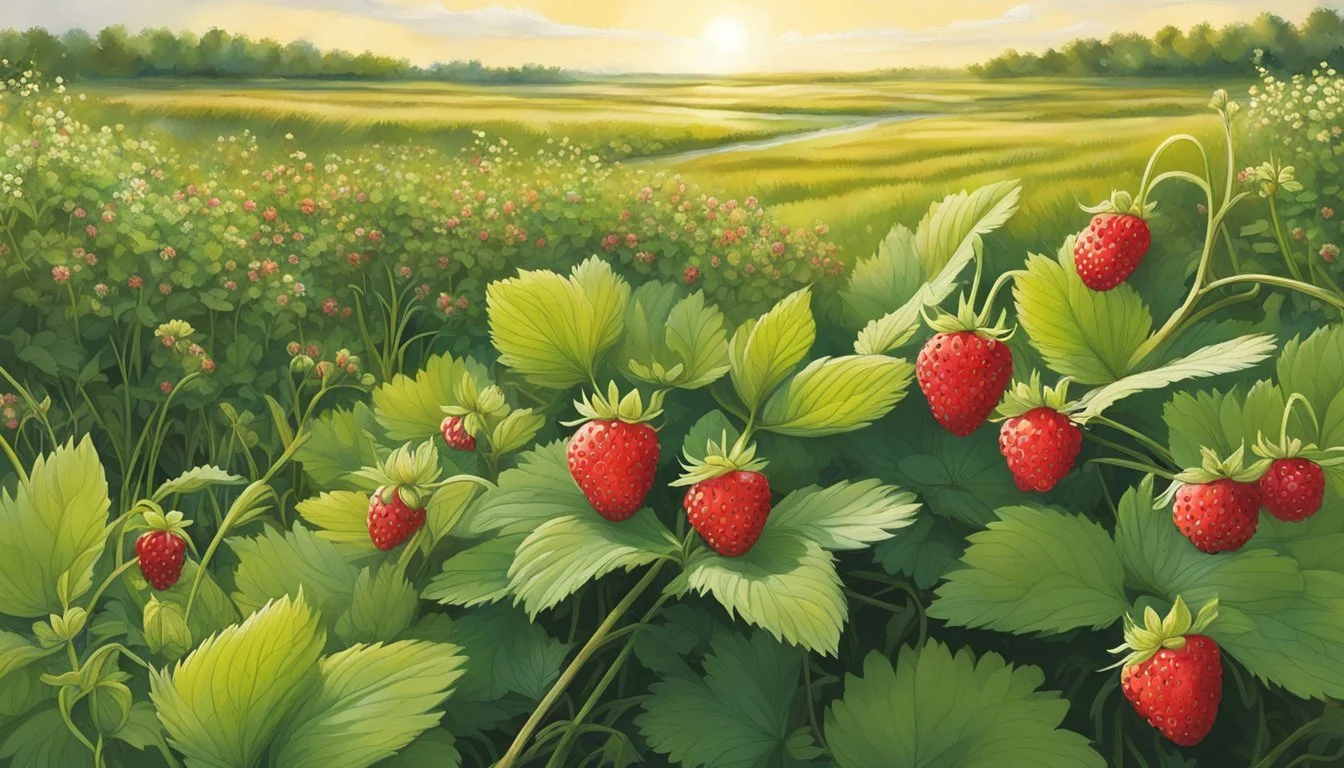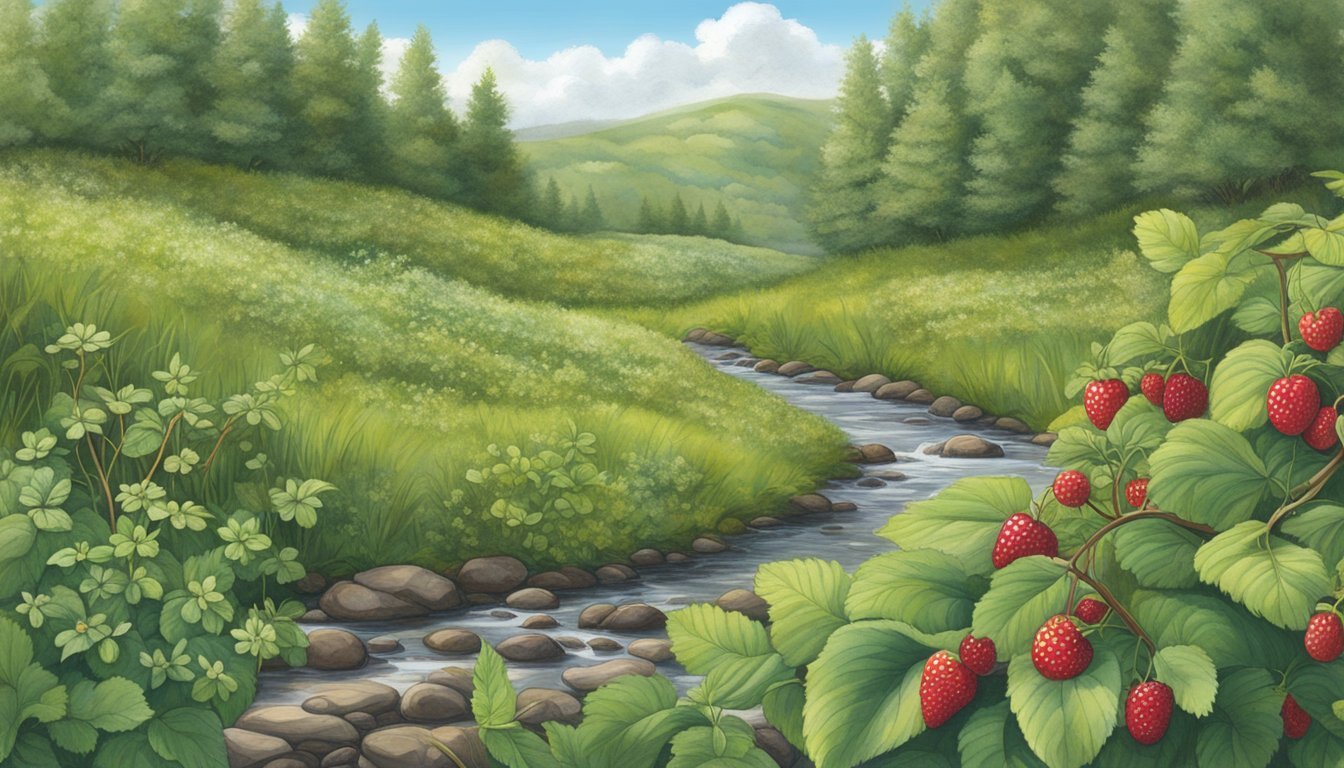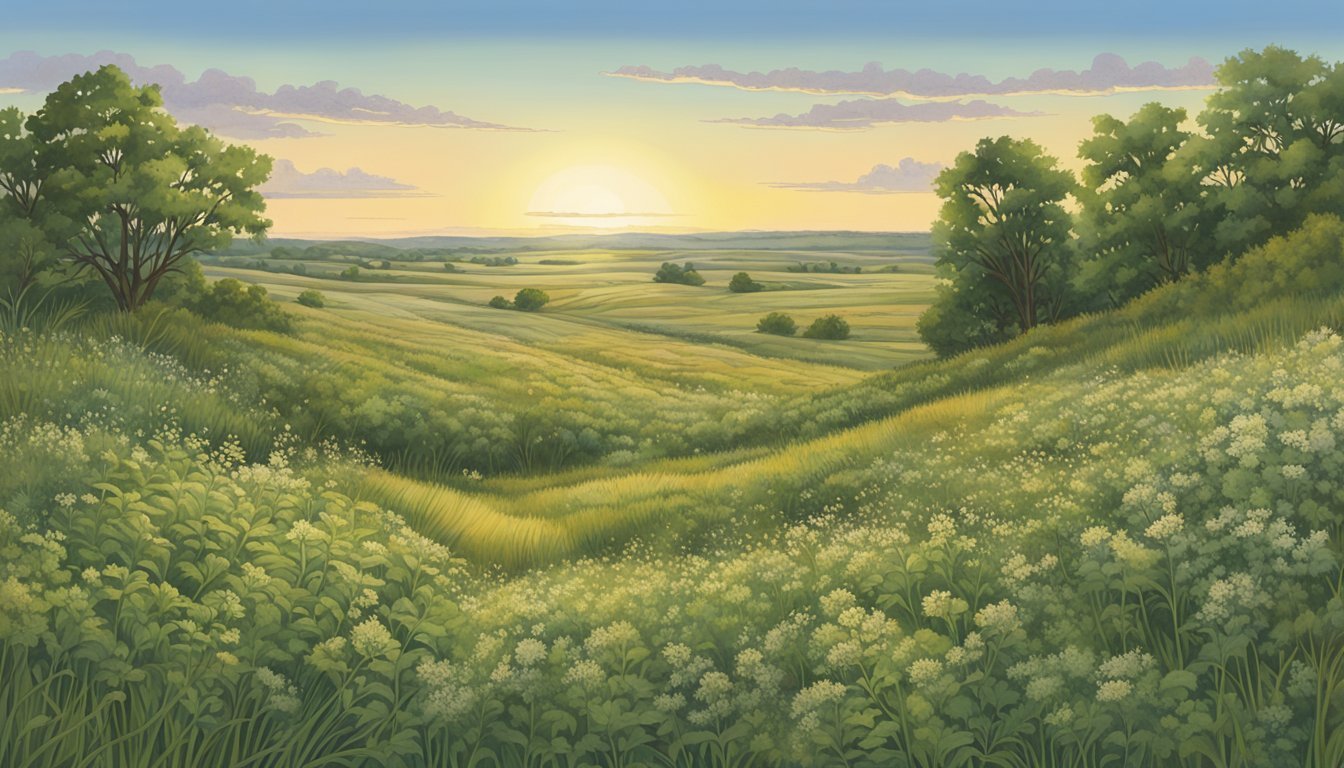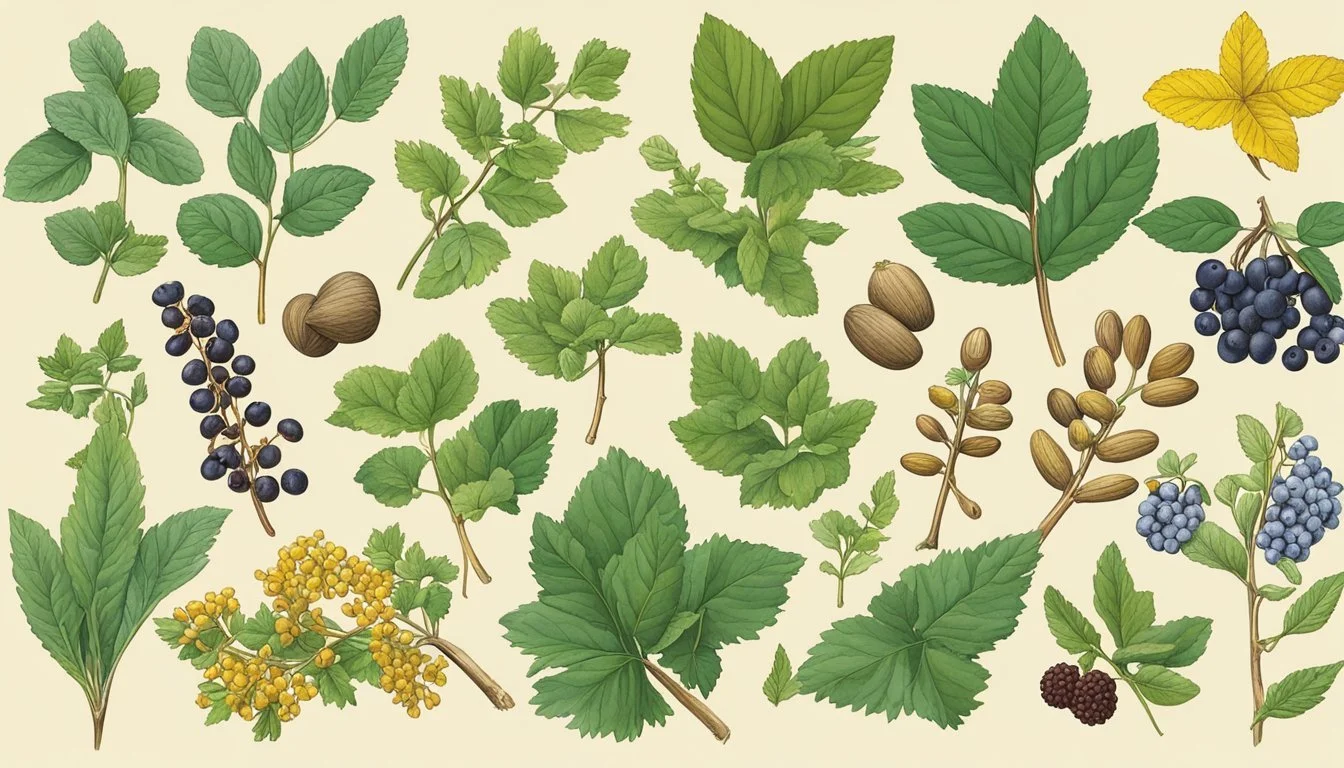Native Edible Plants in North Dakota
A Guide to Local Foraging
This Article is Part of Foraging Guide for All 50 US States
North Dakota's landscape is home to a rich diversity of native plants, many of which are not only integral to the local ecosystem but are also edible. These plants have played a significant role in the cultural and nutritional history of the region. Indigenous peoples and early settlers alike utilized these species for food, medicine, and other purposes. Today, they continue to provide foraging opportunities for locals and visitors interested in sustainable and locally sourced foods.
In exploring the variety of edible native plants found in North Dakota, one discovers species ranging from fruits and berries to herbs and roots. Each plant offers a unique flavor profile and nutritional benefits. For instance, the chokecherry, a small shrub with tart berries, can be found throughout the state, used historically to make pemmican by the Lakota and Dakota peoples. Similarly, the prairie turnip, a legume with an edible tuber, is a staple that was traditionally harvested by tribes in the region.
Understanding the ecology and proper identification of these plants is crucial for their sustainable use. Foraging must be done responsibly to ensure the stability of these species within their natural habitats. Conservation efforts are important to maintain the delicate balance of the ecosystem, which is why any foraging activity should respect the principles of ethical wildcrafting, collecting only what is needed and leaving enough for the plant to continue to thrive.
Interested in Mushroom Hunting in North Dakota?
North Dakota's prairies, woodlands, and river valleys offer a unique mushroom hunting experience. Morels, oyster mushrooms, and puffballs are among the edible species found in the state. With proper identification skills and respect for public and private land regulations, foraging in North Dakota can be a safe and rewarding adventure.
👉 Guide on Mushroom Hunting in North Dakota
Understanding Native Edible Plants
Native edible plants are an integral part of North Dakota's ecosystem, providing sustainable resources. These plants have evolved to thrive in the local climate and offer significant environmental and historical value.
Historical Significance
Native American tribes in North Dakota have long relied on indigenous plants for nutrition and medicinal purposes. For example, the chokeberry served as a staple in the diet of the Sioux and was often used to make pemmican—a mixture of berries, fat, and meat.
Chokeberry (Aronia)
Wild Bergamot (Monarda fistulosa)
Medicinal plants were integral to the physiological well-being of these communities, demonstrating a deep understanding of the land's resources. The systematic use of native plants for both food and medicine illustrates a harmonious coexistence with the natural environment.
Environmental Impact
Native plants are essential in maintaining the health of ecosystems, as they are well adapted to the soil and climatic conditions, requiring minimal maintenance. Their deep root systems help in soil conservation and water retention, mitigating the impact of erosion and drought.
Soil Conservation: Deep roots prevent erosion
Water Retention: Roots capture and hold water
These plants serve as a vital component of the food web, supporting insects, birds, and other wildlife, which contributes to biodiversity and a balanced ecosystem.
Climate and Region Adaptations
In the variable climate of North Dakota, with its cold winters and hot summers, native edible plants exhibit resilience. Temperature adaptations allow these species to not only survive but to thrive under stress conditions.
Table 1: Native Plants and Their Climate Adaptations
Plant Adaptations Temperature Range Prairie Turnip (Psoralea esculenta) Drought-resistant -30°F - 100°F Juneberry (Amelanchier) Frost-tolerant -40°F - 85°F
Gardening with native species minimizes the need for additional resources such as water and fertilizer, making it a sustainable choice that respects the local climate and temperature extremes.
Botanical Characteristics
Native edible plants in North Dakota display a variety of botanical characteristics that aid in their identification and understanding of their uses.
Leaves and Flowers
Yarrow (Achillea millefolium) is recognized by its feathery, fern-like leaves and clusters of small, white to pink flowers. The Prairie turnip (Pediomelum esculentum) has compound leaves that are divided into smaller leaflets. This plant produces purple to white flowers. Many species, such as the Green ash (Fraxinus pennsylvanica), exhibit simple, opposite leaves that may change colors with seasons.
Yarrow:
Leaves: Fern-like
Flowers: White to pink
Prairie Turnip:
Leaves: Compound, leaflets
Flowers: Purple to white
Green Ash:
Leaves: Simple, opposite
Color changes: Seasonal
Roots and Tubers
Prairie turnip and wild onion (Allium canadense) are notable for their underground parts. The prairie turnip’s tuber is starchy and nutritious, while the wild onion's bulb can be used similarly to cultivated onions. (What wine goes well with onions?) In terms of appearance, the wild onion's roots are fibrous and typically white.
Prairie Turnip:
Tuber: Starchy, edible
Wild Onion:
Bulb: Edible, onion-like
Roots: White, fibrous
Stems and Bark
Many native plants feature distinctive stems and bark that facilitate identification. For instance, the elm (Ulmus americana) is known for its rough bark and the ability to withstand harsh conditions. Trees like the ash species, including the white ash (Fraxinus americana) and green ash, have stout stems used for various tools by indigenous peoples.
Elm:
Bark: Rough, durable
Ash (General):
Stem: Stout, useful for tools
White Ash:
Bark/Stem: Gray bark, stout stems
Green Ash:
Bark/Stem: Similar to white ash, slightly different hue
Habitat and Growing Conditions
Native edible plants in North Dakota thrive across various habitats, each presenting unique growing conditions. These resilient species have adapted to the state's climate, requiring specific moisture levels and sunlight exposure.
Forest and Woodland Habits
Forests and Woodlands offer canopy shade and moist soil conditions, favoring the growth of certain native edibles. Understory plants, such as the wild plum (Prunus americana), prosper in these habitats. They are adapted to:
Shade: Partial to full shade beneath deciduous trees.
Soil: Rich, well-drained, moist soils.
Species Shade Soil Moisture Wild Plum Partial-Full Moist
Prairie and Plains Biomes
Prairie and Plains provide a vastly different setting with full sun exposure and well-drained soil. Native grasslands support a diverse range of plants like the juneberry (Amelanchier spp.) that are conditioned to:
Sunlight: Full sun, open spaces without tree cover.
Soil: Deep, fertile, sometimes dry but can be moist following rain.
Species Sunlight Soil Condition Juneberry Full Sun Well-Drained
Wetlands and Riverbanks
Wetlands and Riverbanks in North Dakota are home to numerous moisture-loving plants. Species such as the chokeberry (Aronia melanocarpa) find the wetland habitat ideal due to:
Water availability: Constant supply from surrounding water bodies.
Soil: Saturated, rich in organic matter, often with standing water.
Species Water Soil Type Chokeberry Abundant Moist, Organic
Each of these distinct habitats contributes to the rich tapestry of edible plants available throughout North Dakota.
Popular Native Edible Plants
Native edible plants in North Dakota have served as dependable sources of nutrition and have been traditionally used by indigenous peoples and early settlers. In modern times, these plants offer a combination of flavor, nutritional benefits, and medicinal properties for those interested in local and natural food sources.
Trees and Shrubs
Chokecherry (Prunus virginiana): This small shrub or tree is known for its tart, dark purple berries that can be used to make jellies, syrups, and wines after the removal of toxic pits. Bur Oak (Quercus macrocarpa): The acorns of the bur oak, which require leaching to remove tannins, have historically been ground into meal or flour. Cottonwood (Populus deltoides): While not commonly eaten, the inner bark of the cottonwood was used by Native Americans as a survival food. Aspen (Populus tremuloides): Similarly to cottonwood, the inner bark can serve as an emergency food, and the buds are edible in early spring. Paper Birch (Betula papyrifera): The sap can be tapped in the spring and boiled down into a syrup, much like maple.
Grasses and Herbaceous Plants
Big Bluestem (Andropogon gerardii): An iconic prairie grass whose young shoots can be eaten in the spring when they're tender and sweet. Switchgrass (Panicum virgatum): While primarily used as forage for animals, young shoots can be consumed by humans in moderation. Achillea Millefolium (Achillea millefolium): Also known as yarrow, its leaves are used for their herbaceous flavor and potential health benefits. Asclepias Incarnata (Asclepias incarnata): The shoots and young pods of swamp milkweed are edible when cooked and are noted for their pleasant taste.
Fruits and Berries
Juneberry (Amelanchier spp.): High in nutrition and similar in taste to blueberries, these berries can be eaten fresh or used in pies and preserves. Prickly Pear (Opuntia spp.): The fruit of this cactus, known as "tuna," is sweet and can be eaten raw or made into candies and jellies. The pads, or nopales, are also edible when young and tender.
Each of these plants has secured its niche in the North Dakotan ecosystem, supporting a variety of wildlife and providing food for humans who understand their benefits and know how to properly prepare them.
Wildlife and Pollinators
Native edible plants play crucial roles in supporting local wildlife and pollinator populations in North Dakota. They provide necessary sustenance and habitats that maintain ecological balance and biodiversity.
Plants for Bees and Butterflies
Sunflowers (Helianthus) provide pollen and nectar for bees and offer a rich source of honey. They act as a magnet for a diverse range of bee species.
Purple Coneflower (Echinacea purpurea) is a favorite for butterflies, especially the Monarch, with its nectar-rich blooms.
Goldenrod (Solidago) serves as a critical fall food source for bees and butterflies, supporting them as they prepare for the colder months.
Bird-Friendly Habitats
Wild Bergamot (Monarda fistulosa) attracts hummingbirds with its tubular flowers, offering a high-energy nectar.
Chokecherry (Prunus virginiana) produces fruit that is a vital food source for a variety of birds like robins and sparrows.
Plant Bird Species Benefitted Juneberry Cedar Waxwings, Thrushes Wild Plum Grosbeaks, Cardinals
Supporting Mammalian Herbivores
American Hazelnut (Corylus americana) provides nuts (how long do nuts last?) that are essential food for small mammals like squirrels and chipmunks.
Prairie Clover (Dalea) offers forage for herbivores and is instrumental in soil nitrogen fixation, benefiting the surrounding flora.
Foraging Techniques and Tips
In North Dakota, successful foraging for native edible plants requires safe practices, awareness of the best harvesting seasons, and knowledge of legal regulations.
Safe Identification
Foragers must be able to accurately identify plants to ensure they are safe for consumption. Visual identification is most common, often involving a careful examination of leaves, flowers, and sometimes roots. Using field guides or mobile apps with a database of local plant life can assist foragers in this critical step.
Key characteristics to observe:
Leaf shape and arrangement
Flower color and pattern
Habitat specificity
Seasonal Harvesting
The time of year significantly affects the availability of edible plants. Late summer is particularly abundant, with many native trees and plants offering fruits and nuts. Tracking phenology, the study of cyclic and seasonal natural phenomena, helps foragers understand the optimal times for harvesting different species.
Optimal Seasons for Common Native Edible Plants:
Spring: Wild greens and budding flowers
Summer: Berries and herbs
Fall: Nuts and late-fruiting shrubs
Legal Considerations
Foraging, while a beneficial activity for sourcing food, is governed by state and local laws. Foragers should acquaint themselves with these to avoid legal complications. In North Dakota, some lands may prohibit foraging or require permits. It's also crucial to respect private property and only forage in areas where it is explicitly allowed.
Legal Checklist for Foragers:
Verify public access to foraging locations
Obtain necessary permits or permissions
Adhere to specific area guidelines and restrictions
Incorporation Into Landscaping
Incorporating native edible plants into landscaping in North Dakota offers both aesthetic and ecological benefits. These plants are well-adapted to local conditions, often requiring less water and care.
Garden Design
When designing a garden in North Dakota, one should consider the plant's compatibility with local wind patterns and sun exposure. Plants such as Juneberry (Amelanchier alnifolia) and Wild Plum (Prunus americana) can provide both food and a natural windbreak when positioned properly. Arranging these plants based on their sun requirements ensures healthy growth and fruit production.
Full Sun: Wild Strawberry (Fragaria virginiana), Prairie Coneflower (Ratibida columnifera)
Partial Shade: Virginia Waterleaf (Hydrophyllum virginianum), Wild Licorice (how long does licorice last?) (Glycyrrhiza lepidota)
Low-Maintenance Practices
Native plants in North Dakota thrive with minimal intervention, aligning well with low-maintenance landscaping practices. Using a layering approach by planting taller shrubs and smaller perennials together helps mimic natural ecosystems, reducing the need for fertilizers and pest control. Regular pruning and seasonal cleanup can be sufficient to maintain the health and productivity of vegetation such as Chokecherry (Prunus virginiana) and Hazelnut (Corylus americana).
Land Classification and Use
Taking into account land classification and acreage is key when integrating edible native plants into the landscape. Residential properties might focus on smaller berry-producing shrubs, while larger agricultural lands could allocate areas for nut trees and fruit-bearing understory. The climate of North Dakota, characterized by cold winters and hot summers, should influence the selection of native plants that are resilient and contribute to the land's productivity.
Land Type Suggested Vegetation Purpose Residential Serviceberry, Wild Grape Ornamental, Food-Producing Agricultural Hazelnut, American Plum Windbreaks, Erosion Control Public Spaces Buffalo Berry, Elderberry Wildlife Habitat, Education
Conservation and Restoration Efforts
In North Dakota, conservation and restoration initiatives are fundamental in maintaining the ecosystem's health. They focus on safeguarding native plants and supporting sustainable agriculture, with the local community playing a vital role in these endeavors.
Protecting Native Biodiversity
Conservation programs in North Dakota prioritize protecting native plants that contribute to the region's biodiversity. Native habitats are home to a variety of species, including crucial pollinators that enable plant reproduction and support the food web. Efforts include:
Establishing protected areas to ensure the survival of native plants and wildlife.
Implementing management plans that address invasive species and preserve natural habitats.
Sustainable Agriculture Practices
Agriculture is essential to North Dakota's economy, especially crops like wheat. However, it can impact the native ecosystem. To balance agricultural development and ecosystem health, sustainable practices are encouraged:
Crop rotation, which includes native plants to improve soil health.
Reduced pesticide use to protect non-target species, especially pollinators.
Community Involvement and Education
Community engagement is integral to conservation success. Educational programs inform residents of the importance of native flora and how they can help:
Workshops that teach residents about native plants and their roles in the Great Plains ecosystem.
Volunteer-driven restoration projects enable locals to actively participate in protecting their natural heritage.
Culinary Uses and Recipes
Native edible plants from North Dakota have long provided sustenance and have been integral to both traditional and modern cuisine. These plants not only offer diverse flavors but also bring nutritional benefits that are increasingly recognized in the realm of healthy eating.
Traditional Dishes
The indigenous people of North Dakota have historically incorporated local plants into their diet with dishes that highlight the flavors of the natural landscape. One such traditional recipe is a simple Wild Turnip Stew. To make it, one would peel and dice wild turnips, then slow-cook them with chunks of bison meat. The stew was often seasoned with wild herbs and sometimes supplemented with foraged greens and berries, making use of the region’s bountiful food sources.
Another staple is Sunflower Seed Balls. These were made by grinding roasted sunflower seeds into a paste, mixing it with local honey for sweetness, and rolling the mixture into bite-sized balls. These snacks were not only nutritious but also provided essential energy for long treks or during the winter months.
Modern Culinary Applications
Modern chefs often seek out wild ingredients to create innovative dishes that pay homage to these edible plants. For instance, local potatoes are given a new twist in gourmet kitchens, being transformed into Purple Potato Gnocchi. The gnocchi are infused with native herbs and served with a sage-butter sauce, showcasing the plants' versatility beyond traditional recipes.
Moreover, honey, harvested from local pollinators, is often used as a natural sweetener. Artisan foods like Honey-Infused Ice Cream made with native berries incorporate this natural sweetener to create a link between traditional food sources and contemporary palates.
Healthy Eating and Nutrition
Native plants are a goldmine for those interested in nutrition. The wild potato, for example, is a rich source of carbohydrates, fibre, and vitamins. It can be prepared as Roasted Wild Potatoes tossed in a light coating of olive oil and sea salt (how long does sea salt last?), illustrating how these native ingredients contribute to a balanced diet.
Chokecherries, another indigenous plant, are often used to make a syrup or jelly that is rich in antioxidants. They embody the connection between local flora and nutrition, highlighting the role of native plants as a valuable food source in the context of health-conscious lifestyles.
Medicinal and Healing Properties
Many native plants in North Dakota possess distinct medicinal and healing properties. This section explores how these plants are used in herbal remedies, personal care products, and hold cultural and spiritual significance.
Herbal Remedies
Yarrow (Achillea millefolium) is recognized for its ability to stop bleeding and is often applied to wounds. Traditionally, its leaves are chewed or made into a poultice. White snakeroot (Ageratina altissima), though toxic if ingested in large quantities, has been used carefully in small amounts by Indigenous peoples to treat fever and respiratory ailments.
Plant Use in Herbal Remedies Yarrow Aid in wound healing, reduce bleeding Prairie Smoke Treat gastrointestinal issues, possibly as a tea White Snakeroot Used cautiously for fever and respiratory issues
Personal Care Products
Prairie Smoke (Geum triflorum) has been utilized for its astringent properties and may be found in natural skin care products. Its roots and leaves are thought to have toning effects on the skin.
Plant Application in Personal Care Prairie Smoke Incorporated for astringent properties in skin care Meadow Anemone Potential inclusion for its softening agents
Cultural and Spiritual Significance
Indigenous cultures have revered plants like Yarrow and Meadow Anemone (Anemone canadensis) for their spiritual and healing capacities. These plants are often part of ceremonies and traditional medicine practices, reflecting a deep understanding of the natural world's offerings.
Plant Cultural and Spiritual Use Yarrow Used in ceremonies and traditional healing practices Meadow Anemone Valued for its spiritual significance
Identification and Resources
When foraging for native edible plants in North Dakota, accurate identification is crucial. Enthusiasts should consult a variety of resources to ensure safe and sustainable harvesting. Below is a guide to resources available to those seeking knowledge on indigenous flora.
Field Guides:
Native Plants of the Northern Plains by Allen Smith includes detailed illustrations conducive to proper identification.
Edible Wild Plants of the Prairie by Kelly Kindscher provides both identification assistance and ethnobotanical information.
Online Databases:
The North Dakota State University (NDSU) Ag Department maintains an extensive online database of native plants, including edibles.
Various mobile applications, such as Wild Edibles Forage and iNaturalist, are helpful for on-the-go identification.
Workshops and Education:
NDSU Extension offers workshops on native plant identification and sustainable foraging practices.
Local nature centers, such as the Dakota Prairie Grasslands, periodically conduct guided walks and educational programs.
Communities:
Regional foraging groups and online forums can be valuable sources of shared knowledge and experience.
Local indigenous communities often possess generational knowledge on local edible plants.
When using these resources, individuals should emphasize responsible foraging—which includes respecting private lands, taking only what is needed, and ensuring the continued health of wild plant populations.
Recommended Practices
Always have a field guide or digital resource at hand.
Attend local workshops for hands-on learning.
Contribute to community forums and learn from experienced foragers.
Coordinate with land management for permission and advice.
Appendices
The appendices are designed to provide practical resources for identifying and utilizing native edible plants in North Dakota. They offer a detailed Plant Index, a Foraging Calendar tailored to seasonal availability, and contact information for Conservation Contacts dedicated to preserving local flora.
Plant Index
The Plant Index offers an organized catalog of North Dakota's edible plants, including native trees and vegetation.
Common Name Scientific Name Family Prairie Smoke Geum triflorum Rosaceae Yarrow Achillea millefolium Asteraceae Meadow Anemone Anemone canadensis Ranunculaceae Boltonia Asteroides Boltonia asteroides Asteraceae
*Note: This list is not exhaustive and represents a selection of the region's diverse edible flora.
Foraging Calendar
This calendar provides a seasonal guide to foraging for native plants in North Dakota.
Season Plants Available Spring Meadow Anemone, Yarrow Summer Boltonia Asteroides, Prairie Smoke Fall Yarrow, Prairie Smoke
All plants are subject to regional availability and conservation status.
Conservation Contacts
For those seeking guidance or looking to participate in conservation efforts, the following entities can be contacted:
Native Plant Society of North Dakota: Focuses on preservation of native plants and their habitats.
North Dakota Forest Service: Offers information on native trees and forest conservation efforts.
Here, individuals can find additional resources and become involved in protecting the state’s natural heritage.







